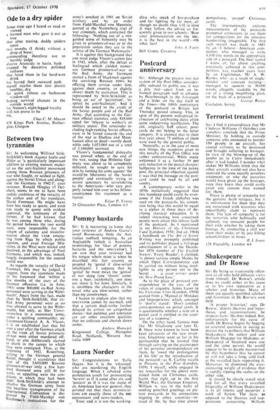Postcard anniversary
Sir: Although the present two tier system of the Post Office consider- ably reduced its public use, it was a pity that—apart from an in- formed paragraph well in advance by Peterborough in the Telegraph and a letter on the day itself in the Times—the 100th anniversary of the postcard in Britain last Thursday passed unsung. This, in spite of the present widespread in- clination of celebrating dates often quite undeserving recollection. The old, originally buff colour, post- cards do not belong to the latter category. It is claimed that in their first year about 75 million of them were used by the general public.
Naturally, as in the case of most new things, the reception given to this novelty of the Post Office was rather controversial. While many welcomed it as a further 50 per cent reduction in the postal charges: halfpenny in the time of the penny post, the principal objection against it was that the message on the post- card could be read by all and sundry.
A contemporary writer in the 1870s maliciously suggested that this handicap could easily be over- come if the Greek alphabet was used on the postcards, his conten- tion being that this would be equal to a cipher in these days of de- clining classical education. It is indeed interesting how concerned people were about this inborn fault of the postcard. As I mentioned in my History of the Christmas Card (London, 1954; 2nd ed. 1964) a handbook on The Art of Secret Writing was promptly published and its publisher placed a full-page advertisement of it in the Decem- ber 1870 number of The English Society. 'Every Reader', it claimed, 'is shown various simple Modes by which Open Correspondence can he carried on without being intel- ligible to any person not in the Secret . . . a great service under the New Pasta! Law.'
As to the place of postcard cor- respondence in the eyes of the rulers of etiquette. James Laver in his Victorian Vista (London, 1954) quoted from a 'Manual of Mistakes and Improprieties' which, amongst its 'don'ts' stated: 'Don't conduct correspondence on postal cards. It is questionable whether a note on a postal card is entitled to the cour- tesy of a response.'
On the other hand, famous men like Mr Gladstone and later G. B. Shaw were known to have been keen advocates of the new inven- tion. Gladstone went so far in his partisanship that he insisted that through carrying on the greater part of his personal correspondence on them, he 'owed the prolongation of his life' to the introduction of the postcard—as R. Carline recalls in Pictures in the Post (London, 1959). I myself, while engaged in my researches for the above men- tioned book on Christmas cards, learnt that right up to the first World War, the German Emperor. William it, was in the habit of sending pencilled greetings on pic- ture postcards to his connections reigning in other countries—in- stead of the, by that time almost
compulsory, 'proper' Christmas cards.
The internationally uniform measurements of the postcards prompted enthusiasts to use them for competitions for the minutest handwriting imaginable. The first .itch record was made in 1881 by an-1 believe—American com- petitor, who managed to write 4.100 tiny words on the appropriate side of a postcard. The final record I know of. far above anything previously achieved in this com- petition, was reached years later by an Englishman, Mr A. W. Barnes, who—as a result of single- minded and constant training— managed to squeeze in 30.000 words, allegedly readable by the use of a strong magnifying glass, on the back of a postcard.






































 Previous page
Previous page